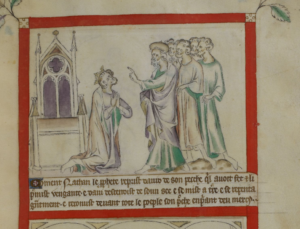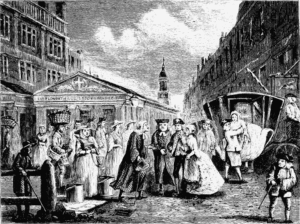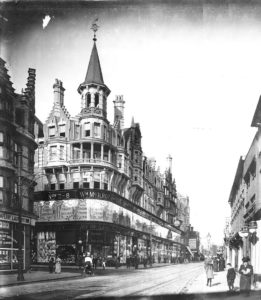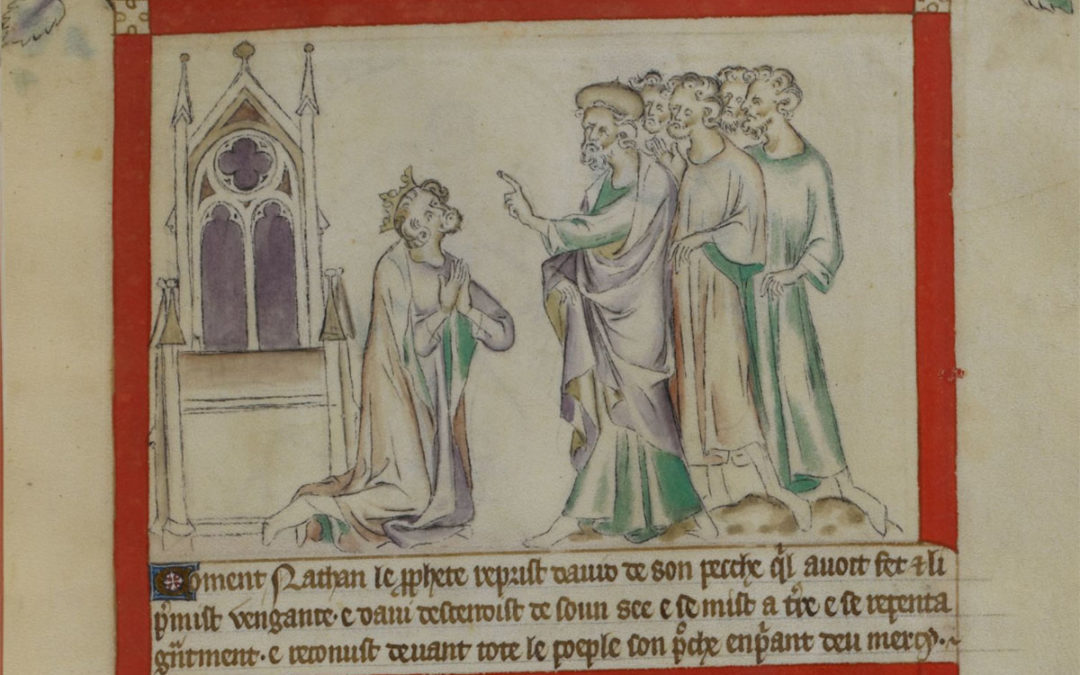Now that summer is definitely here, it’s time to share our BBIH top ten summer reads. We have compiled a list of some of the most interesting and/or surprising items that we have indexed over the last six months for the Bibliography of British and Irish History. We hope you agree that the following resources indicate the wide range of material available on the BBIH and that this showcase will encourage you to do some exploring of your own. In the meantime, sit back and relax as we guide you through a chronological list of current research on a variety of topics.
First up is the article St Edward’s Chair in the Queen Mary Psalter by Kathryn A. Smith, in the Electronic British Library Journal. The Queen Mary Psalter (British Library, Royal MS 2 B VII) is a beautiful illuminated manuscript that was made at the beginning of the fourteen century, possibly for Isabella of France (1295–1358), wife of Edward II. This article examines one of the tinted drawings at the beginning of the manuscript that depict scenes from the Old Testament. The drawing in the upper section of folio 58r shows Nathan reproving David, featuring a chair that is perhaps the earliest known depiction of the coronation chair in Westminster Abbey, commissioned by Edward I and possibly used for Edward II’s coronation in 1308. This article discusses the artistic and political messages that are contained within this image, alongside other images on folios 15v and 17v, which show the Egyptian pharaoh giving Joseph his dove-topped virga, part of the English royal regalia. The symbolism of these royal objects is considered within their biblical narrative, and how this may have been relating a message about the nature and limits of royal authority.

The Queen Mary Psalter (British Library, Royal MS 2 B VII)
Moving to the early modern period now with Hazarding for marriage: John Blagrave’s lottery for maidservants by Richelle Munkhoff. This slightly alarming tale tells of a bequest made by mathematician John Blagrave (d. 1611) in order to assist one young woman a year looking to marry. He offered a sum of twenty nobles to any maidservant in the Borough of Reading – to be chosen by the casting of lots, which in Blagrave’s opinion would make it less open to favouritism. This article discusses the popularity of games of chance in seventeenth-century England, and more importantly, follows the fate of these ‘lucky’ women over a fifty-five year period, and explores the impact the lottery had on them.
Continuing the dubious marriage theme, but moving onto the eighteenth-century, we have Clandestine weddings at the Fleet Prison, c.1710–1750: who married there? by Jacob. F. Field. This article explores the thousands of marriages that took place at the Fleet prison, where due to a legal quirk clergy were allowed to perform marriages on couples without banns or licenses. The author discusses how Fleet prison (or the area just outside) witnessed more weddings there than any other place in England, and looks at the quantitative data of the couples married there, examining their premarital status, origin and occupation, and also couples living outside of London who married there.

A wedding in the Fleet. (From a Print of the Early Part of the Eighteenth Century.) From British History Online
Staying in the eighteenth century but moving further afield, we have Kyle T. Bulthuis’s article Oceanic barriers: The British–American divide among revolutionary black Atlantic writers. This fascinating research explores the difference between black writers in the last half of the eighteenth century against the backdrop of the American War of Independence. The author argues that although they had gone through similar experiences, such as the suffering of slavery and evangelical religious conversions, writers in the United States versus Britain or the British Empire developed differing narrative styles. Black American writers tended to focus more on community and personal piety, and less on the issue of slavery and political issues, whereas Black British writers actively took on political issues such as antislavery, and emphasized their African or international identity. The author suggests that these differences were shaped by the societies they were living in, and provides an important context for transatlantic black writers.
Into the nineteenth century now, with Performing emotion and reading the male body in the Irish court, c. 1800–1845 by Katie Barclay. This article explores attitudes towards the body and emotion in the justice system, and how men’s bodies were read to decide their identity and character in the court room. In an era when physiognomy was a respected science, their outward appearance was assessed, such as their attire and physical bearing, but their emotional performance was also analysed. Newspaper reports of criminal trials in early nineteenth-century Ireland are used to explore these issues, and how a man’s character might be determined based on his emotional bearing, and therefore ultimately influence the outcome of the trial.

An Irish Petty Session
Following on with more attitudes towards the body, ‘Tall and lithe’–The wage-height premium in the Victorian and Edwardian British railway industry by Peter Anderson explores the concept of a ‘wage-height’ premium, that is, whether tall people get paid more, even for jobs not reliant on physical strength. Using data from over 2, 200 English and Welsh railwaymen staff, the author analysed the Victorian and Edwardian period to see whether this premium applied. From the mixed results, it was found that taller men working in skilled grades that required a higher cognitive and non-cognitive skill to strength ratio were eligible to greater privileges, yet those in entry-level positions that were physically demanding were not. The author concludes that taller railwaymen benefited because height indirectly measured their cognitive and non-cognitive abilities, not their strength. As the railways were the major employer in this period, these findings add further interest to research in the British labour market.
Time for some retail therapy now. Staying around the turn of the twentieth century, next up is Cathedrals of consumption? Provincial department stores in England, c.1880–1930 by Jon Stobart. Using trade directories, the author examines the regional distribution of department stores, and considers their origin and development from the 1880s. This article focuses on provincial rather than urban stores, looking at retail architecture, selling practices and general ambiance of a sample of stores, and considers their individuality against the expected norms of a standard department store.

Oxford Road, Reading (Wikipedia)
A slightly more controversial topic, albeit still on a the them of leisure, is ‘The Master is the Mistress’: women and fox hunting as sports coaching in Britain by Erica Munkwitz. Exploring how women participated in field sports, and particularly fox hunting at the turn of the century, this article looks at how women held positions of authority such as Master of Hounds. This position meant women were participating in teaching and training, as well as management of all those involved in the hunt. These leadership roles by women were in place well before they were given the vote in 1918, and the author considers how advances in sport may have influenced social and cultural perceptions of women in other areas.
At number nine, the article Empire, repetition, and reluctant subjects: British home movies of Kenya, 1928–72 by Christine Grandy examines the colonial and post-colonial conception of Africa through the use of cine-cameras by British visitors. The production of these amateur films, made to take back home for viewing in a domestic environment, highlights the relationships between the film-maker and film subject, often through the ‘imperial gaze’. Looking at both colonial and post-colonial films from Kenya, this article discusses the images of power and control within this visual culture, and how different behaviours and attitudes are reflected.
Last but not least, we have Computer dating in the 1970s: Dateline and the making of the modern British single by Zoe Strimpel. Discussing the rise of the British match-making industry after the 1970s, this article looks at the success of computer dating agency Dateline though its marketing in the late seventies. This article explores the change in language within this genre with the introduction of a more ‘scientific’ approach. Dateline enabled single people to have more control over their fate, which the author suggests was a foretaste of the pressures faced by people dating now in the twenty-first century.
We hope you enjoyed our selection of articles, and if they have whetted your appetite, here’s a few more we found just as interesting:
The Tramper’s Tale: poverty, vagrancy and witness by Peter Leese.
‘A Wicked Operation’? Tonsillectomy in Twentieth-Century Britain by Louis Dwyer-Hemmings
‘In the Greatest Wildness of my Youth’: Sir Charles Hanbury Williams and Mid-Eighteenth-Century Libertinism by Richard Butterwick‐Pawlikowski
Phyllis M. Tookey Kerridge and the science of audiometric standardization in Britain by Jaipreet Virdi and Coreen McGuire
Happy reading.

